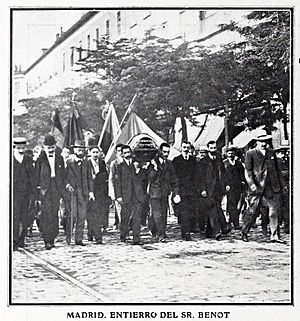Eduardo Benot facts for kids
Quick facts for kids
Eduardo Benot
|
|
|---|---|
 |
|
| Ministry of Development | |
| In office 11 – 28 June 1873 |
|
| Preceded by | Eduardo Chao |
| Succeeded by | Ramón Pérez Costales |
| Member of the Congress of Deputies | |
| In office 29 March 1893 – 1 July 1895 |
|
| Constituency | Madrid |
| Member of the Congress of Deputies | |
| In office 5 June 1873 – 8 January 1874 |
|
| Constituency | Algeciras (Cádiz) |
| Senator | |
| In office 1872–1873 |
|
| Constituency | Province of Girona |
| Member of the Congress of Deputies | |
| In office 16 February 1869 – 2 January 1871 |
|
| Constituency | Jerez de la Frontera (Cádiz) |
| Seat Z of the Real Academia Española | |
| In office 14 April 1889 – 27 July 1907 |
|
| Preceded by | Cándido Nocedal |
| Succeeded by | José Rodríguez Carracido |
| Personal details | |
| Born | 26 November 1822 Cádiz, Spain |
| Died | 27 July 1907 (aged 84) Madrid, Spain |
| Political party | Federal Democratic Republican Party |
| Occupation | Politician, lexicographer, poet, educator, academic, editor, journalist, mathematician, playwright, academic |
Eduardo Benot Rodríguez (born November 26, 1822 – died July 27, 1907) was an important Spanish figure. He was a lexicographer (someone who writes dictionaries), a poet, and a teacher. He also worked as a politician.
Benot believed in a type of government called federal republicanism. This means he wanted Spain to be a republic with different regions having some power. He was a supporter of Francisco Pi y Margall. For a short time, he was the Minister of Development during the First Spanish Republic.
Contents
Eduardo Benot's Life Story
His Early Life
Eduardo Benot was born in Cádiz, Spain, on November 26, 1822. His father came from Italy. As a child, he was often sick.
He went to school at the Colegio de San Pedro and later at the Colegio de San Felipe Neri. Even as a teenager, he started writing for a newspaper called El Defensor del Pueblo. He also wrote for La Alborada and created three plays for the theater.
In 1840, he began working for the local charity office. Later, in 1848, he became a teacher at San Felipe Neri. He soon started publishing books about grammar. In 1857, he taught about mapping and stars at the Naval Observatory in San Fernando.
A Time of Change in Spain
After a big change in Spain called the Glorious Revolution in 1868, Benot became a member of the Constituent Cortes. This was a special group that helped create a new constitution. He was chosen to represent the area of Jerez de la Frontera in Cádiz in the 1869 election.
He supported a plan by Francisco Pi y Margall in 1870. This plan wanted a "pactist" federalism. This meant that different parts of Spain would agree to work together. Later, he was chosen to be a Senator for the province of Girona from 1872 to 1873.
When the First Spanish Republic was declared in February 1873, Benot was again elected to the Congress of Deputies. This time, he represented Algeciras in Cádiz. In June 1873, he became the Minister of Development. This was under the government led by Pi y Margall.
The Benot Law
Benot was a minister for only about 17 days. But in that short time, he did important things. He helped create the Instituto Geográfico y Estadístico. This group later became the National Geographical Institute and the National Statistics Institute.
He also worked on a law about child labour. This law was called the "Benot Law." It was published after he left his government job. This law was the first time the Spanish government tried to control how children worked. It aimed to protect child workers and ensure they could go to school. However, this law was not fully put into action. He also made local governments pay teachers what they were owed. After his time as minister, Ramón Pérez Costales took over his role.
After a political change in 1874, Benot had to leave Spain. He went to Portugal. There, he started a newspaper called La Europa. Later, he was made to return to Spain by the authorities.
Later Years and Legacy
Eduardo Benot had been a special member of the Royal Spanish Academy since 1860. This is a very important group for the Spanish language. Later, he became a full member on April 14, 1889. He gave a speech called ¿Qué es hablar? (What is speaking?).
Many people have praised his work on Spanish grammar. They say his ideas were very "modern." Some even think he was a "direct precursor" to how we study language today.
Benot returned to the Lower House of Parliament. He was elected to represent Madrid in the 1893 election.
When Pi y Margall died, Benot took over as the leader of the Federal Democratic Republican Party. However, he could not stop the party from splitting in May 1905.
Benot became sick and slowly lost his eyesight starting in 1901. He died without much money in Madrid on July 27, 1907. His funeral was held the next day. Many important people and republican supporters attended. Benot was buried in the Civil Cemetery in Madrid. He was buried in the same tomb where Pi y Margall had first been laid to rest.
See also
 In Spanish: Eduardo Benot para niños
In Spanish: Eduardo Benot para niños



